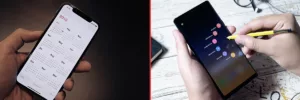We all know what this is all about; the 11 years’ bloody battle between Android and Apple, overstock vs simplicity, cute vs monstrous; and well, lagging vs smooth-going. Many people think that this year’s Samsung Galaxy Note 9 has set the standards on what an android phone can do. And no, I’m not talking about the S-pen, the AI loaded camera, or the design. In fact, the Note 9 is not that much of an upgrade from last year’s Note 8. I’m talking about the number one complaint hardcore Samsung phone fans have always complained about: The lag.
What is the lag factor and why does it matter?
For most people, buying a portable horsepower gadget like the Galaxy Note means one thing: super-fast and reliable performance. But unfortunately, life is not perfect and so are the Notes. Use them for one year, heck, one month and you will start to notice minor hiccups here and there. Use them for over a year and you will find them getting slower by the day and this goes for all Samsung phones that are below the Note standards. But why? This is easy to answer: too many features and options. In fact, for many people, the Note smartphone is too much of a phone. The list of features goes on and on. In fact, many Note series users never use or discover all of the features that the Galaxy Note is fitted with.
This doesn’t mean that the iPhone is exempt from the lag factor
Now for the elephant in the room; the iPhone and why people really buy it. Simple use and no lag. Now, don’t overthink this. The iPhone has a lifespan equal to that of the Samsung Galaxy Note series: approximately 3 years. But here’s the thing, after a year’s use, people find that overall it force closes apps more often than when first bought but does not lag like most android phones including the Samsung ones even though the RAM, CPU power of the latter diminishes that of the iPhone. The combination of too many features and a sleazy touchwiz skin is simply the android’s biggest roadblock. People simply prefer force closure to lag.
Until now
According to Flossy Carter, a YouTube Tech star, with almost one million subscribers, who has posted videos testing rigorously every Samsung phone that has ever been released, this year’s Note 9 or even the Galaxy S9 and S9+ are different from previous Samsung launches.
Flossy explains how it has always been the case whenever he puts a brand new Galaxy Note to the test the results were mediocre. The first month always witnesses minor lags when put on max performance, and by the end of the year he would retire the giant phablet indefinitely and label it an underperformer. A few days from now it will have been a month since the official release of the new Note and Flossy is confident for the first time that Samsung has finally addressed the lag dilemma that the new Android phones are usually afflicted with.
Flossy also notes that if you find your Samsung Galaxy Note lagging, it may not be lagging. It is possible that the cause is due to 2 reasons: Bixby and bad transition effects; otherwise known as touchwiz.
How can Bixby slow your phone? Well, Flossy says in his Note 9 review video that if you swipe to the left for quick access to Bixby and then try to swipe right for other apps, your phone will lag for a second and it might seem that your new Note is slowing you down but it isn’t. Bixby is the one slowing the phone and if you turn it off from the settings you will find no problem at all if you press the Bixby button instead of swiping to the left as usual. This answer came after many of Flossy’s fans expressed their concern that their new Note 9 was lagging when it actually wasn’t.
The second reason for a minor head-scratching lag is the bad transition effect or touchwiz skin that Samsung enables as a default option.
Here’s how this works: You press the power button and look at the front-facing camera to unlock your phone, the screen lags a little bit and it might get into your head that the Iris sensor is faulty or the phone is already lagging. It’s neither. The problem is a hidden transition effect embedded into the lock screen. It is supposed to give a little effect so as to add some life into the action of unlocking your phone.
This touchwiz also works when you swipe through apps and when you open apps.
The good news is that you can lower the transition effect to 1% from the settings and the lag will disappear, or you can go to the developer mode part of the Note 9 and you can tweak it to remove the transition effect altogether. This is a very subtle lag problem and Flossy confidently says that if you do the already mentioned steps your phone should be running silky smooth without any problems at all.
Flossy is not the only Youtuber who has noticed this new improvement, Android Authority; a famous YouTube channel has praised the Note 9 in comparison to last year’s Note 8 and its enhanced specs.
How did the rivalry between Apple and Samsung end exactly?
Well, Apple fans have been boasting the iPhone’s combination of a simple user experience and a powerful performance. This year’s Note 9 will be the one to set the standard of what a smartphone should be: super powerful and lag-free combined with a battery that dwarfs that of the even bigger iPhone XS max.
The rivalry seems to be ending. The new Note 9 seems to be equipped to dominate, not just compete.








